Q&A – Ask Neil: August 18, 2022
(Please read these instructions carefully.)
We’ve received really nice comments on this much-expanded way of addressing questions I’m asked. Before you post your own question, I might suggest you look at recent issues to see if someone else has already asked it. You might find your answer there.
How to submit your question…
• Click here to post your question.
• After you submit your question, a new window will pop up giving you the address to which you can e-mail a photo to accompany your question. Clear, medium-resolution photos. (Try to avoid low-res thumbnail photos, please, in case I have to zoom in to see things.)
• Please only post your question one time.
• One question per reader, please.
• Please use this only for posting questions – not for standard emails.
• Watch for your answer in the following week’s e-gardens.
• I choose those of greatest general interest. For example, plant IDs seldom make the cut.
• I must have your first name or initials.
• I must have your city or county. (Texas is a very large state.)
QUESTION 1
WOULD SPARTAN JUNIPERS LOOK GOOD WITH LEYLAND CYPRESS?
Question: We have eight Leyland cypress trees creating a natural privacy line. We would like to extend it by another 10 to 20 feet. Local professionals are suggesting Spartan junipers instead. What are your thoughts? Cynthia G., Heath.
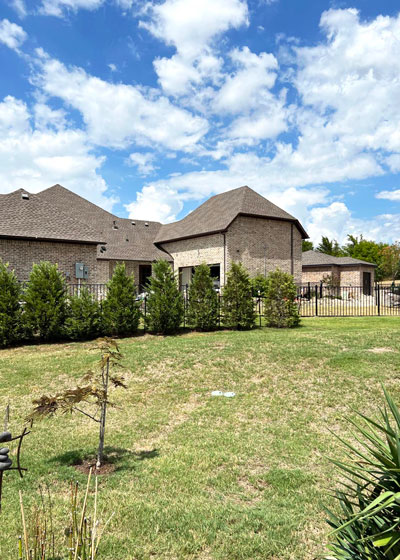
Answer: I have some bad news. Both plants that you mentioned have serious and fatal potential disease problems. Leyland cypress are dying due to Seiridium canker. My own conservative guess would be that it has killed 75 or 80 percent of the Leyland cypress plants that existed in Texas 10 years ago. There is no preventive measure nor is there a control. Here is information from Oklahoma State University.
As to Spartan juniper, it may be my favorite of all junipers, but it is subject to a disease known as Kabatina twig blight that has killed the two that I have tried. Here is information on two twig blights from Clemson University.
You mentioned that you want a “natural“ screen. I would suggest eastern red cedar plants instead. Set them 18 to 20 feet apart, maybe in a zig-zag pattern. Any closer than that and they will crowd one another out due to shading. Actually, your Leyland cypress plants are too close together as they are planted. I’m sorry for all the bad news. You might also consider Nellie R. Stevens hollies spaced 8 or 10 feet apart and allowed to grow to full height. Plant them in October, and plan on watering them by hand for their first couple of years until they become well established.
QUESTION 2
IS IT TOO LATE TO PLANT PRIDE OF BARBADOS SEED?
Question: I have some Pride of Barbados seeds I want to plant in full sun on the west side of my house. Is it too late to plant them this year? If so, how and when should I do it? Bob A., Allen.
Answer: You need to start them in 4-inch pots indoors (preferably in a greenhouse or very bright sunroom) in January or February so the transplants with be tall and vigorous enough to survive on their own when planted into the ground in mid-April (after danger of frost has passed in Allen). Here is a link to the story we ran on the plant here a few weeks ago.
QUESTION 3
APHIDS OR HEAT? WHAT DESTROYED MY CLEMATIS? WILL IT COME BACK?
Question: Aphids destroyed my clematis before it bloomed. I sprayed it with an insecticide but with the heat one plant looks dead and the other is only green at the top. When and how much should I prune them? Will they come back? Dorothy C., Sherman.
Answer: This looks like sweet autumn clematis, the one that blooms in late summer and early fall. I’ve grown this plant for 40 years and I don’t remember ever seeing aphids cause any problem with it. This looks like it was caused entirely by the hot, dry weather. You always want to prune sweet autumn clematis back to about 18 inches around Thanksgiving to get fresh new growth the following spring. Hopefully your plants will have enough vigor to come back.
QUESTION 4
WHY AREN’T PURSLANE PLANTS BLOOMING?
Question: Why aren’t my purslane blooming more? Usually, they are full of blooms at this time of year. I fertilize them with a general-purpose fertilizer. Maybe I’m not feeding them often enough. I water them almost daily. Mohannah P., Fort Worth.
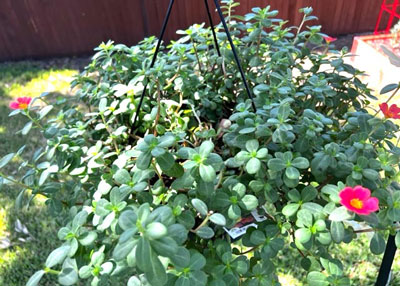
Answer: I’ve grown hybrid purslane for more than 40 years and I have always observed it to slow down in flower production by this time of year. Moss rose (portulaca) does the same thing. Ramping up the water-soluble nitrogen fertilizer will help keep it blooming longer, but as the weather gets cooler and the days get shorter it will begin to shut up shop. I have brightened your photograph so we could see it better. My first impression was that you have it growing in a dark setting. Purslane needs full sunlight. I can’t tell if that’s what you have here, but I thought I’d at least mention that.
QUESTION 5
ARE SHOOTS FROM FROZEN GRAPEFRUIT TREE WORTH SAVING?
Question: I had a fruit-producing grapefruit tree until it froze in February 2021. It sent out a bunch of shoots shrub-form last year. I cut them back to the ground. If I left them what would happen? Laura P., San Antonio.
Answer: I would advise you to get a new and vigorous tree from a local nursery next spring. You’ll want to make provision to protect your tree in future winters. You’re very far north to be growing them.
QUESTION 6
WHY IS DWARF MONDO TURNING BROWN?
Question: I am losing the battle with my dwarf mondograss. I use it all over my yard in shady areas and I water it every three days for at least an hour. What is happening? Is standard mondograss any more sun-tolerant than the dwarf? Judy B., Coppell.
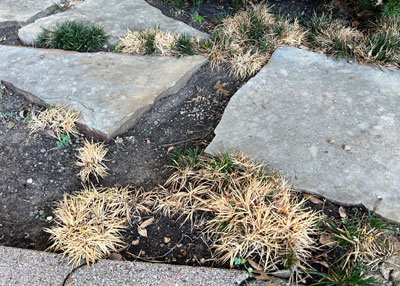
Answer: Dwarf mondograss is not my favorite groundcover. It’s not nearly as dependable as standard mondograss from a standpoint of durability to sun, cold, drought and even crown rot. In looking at your photo, please permit one comment that may or may not be accurate. The soil directly around the dwarf mondograss appears to be wet, but the soil adjacent appears quite dry. It seems to me that you need to soak it much more heavily. The dry soil will wick the moisture laterally to the detriment of your dwarf mondo. That could be where your problem came from.
QUESTION 7
IS IT TIME TO FERTILIZE ST. AUGUSTINE?
Question: We are new to Texas and to St. Augustine grass. Is this the time to fertilize it or do we need to wait? This grass is a puzzle. Some looks great, while other spots look awful. FYI, we have 25 pecan trees. Kathy S., Granbury.
Answer: Welcome to Texas! Watch the Gardening This Weekend portion of e-gardens and I will keep you updated on proper times to fertilize all of your plants, your lawn included. You may have noticed the stories that I have run recently on gray leaf spot, the fungal disease that attacks St. Augustine when we apply nitrogen in the heat of summer. The next time you would want to fertilize your lawn would be after the first significant cool spell in September. That probably will be around September 5-15. Apply an all-nitrogen fertilizer with upwards of half of that nitrogen in slow-release form. You might also want to check the St. Augustine diagnostics information I have on my website.
QUESTION 8
WHAT HAS HAPPENED TO MY ANTHONY WATERER SPIRAEA?
Question: My Anthony Waterer spiraeas are really suffering. I usually cut them back each winter and they come back anew. Should I cut them back now? Have I kept them too wet? Too dry? Too hot? Stephanie M., Denton.
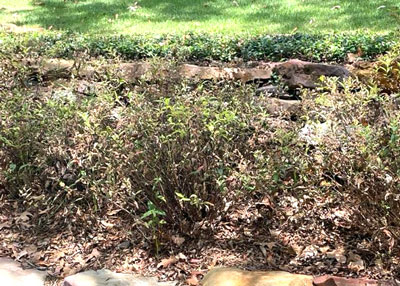
Answer: It would have been extremely difficult to have kept them too wet this summer, so I’m going to rule that out. I’ve grown them for 45 years, including a few summers that were this bad or worse, so I’m going to rule that out. I can’t make out much detail in the photo, but my guess is that the plants got too dry one or more times. So many of our shrubs have faced that same fate. If you want to trim them back some to tidy things up you could do so. Keep them watered and see if they offer to send out new growth this fall.
QUESTION 9
WHAT CUTFLOWERS COULD BE GROWN IN 3-4 HOURS OF SUNLIGHT?
Question: I have a bed that gets 3-4 hours of direct sun. I would like to plant it with flowers to cut and bring in the house. What perennials would be large enough and last a good while? Marsha G., Fort Worth.
Answer: Your huge limitation will be that small amount of sunlight. Most flowering perennials, especially the big ones, need 6-8 hours of direct sunlight daily. And what you consider “long-lasting” may not be what they will deliver when brought into indoor conditions. You might plant Texas Gold columbines, Lenten roses, spider lilies, and summer phlox, but also include flowering shrubs oakleaf hydrangeas and Chinese snowball viburnums. Don’t overlook variegated and decorative foliage such as ferns, leopard plant, umbrella plant, aucuba, elephant ears and hostas.
QUESTION 10
WHAT ABOUT MOVING TO NATIVE MEADOWS?
Question: Given the water that lawns use, do you have any thoughts on moving to native meadows instead? Many western cities are providing cash incentives, but Dallas requires a maximum (grass?) height of 8 inches. Jose B., Dallas.
Answer: The great thing about landscaping is that there is room for all kinds of tastes. That one does not appeal to me, but I certainly don’t disparage those who like it. Our family uses our lawn for recreation. We also live in an area without fire hydrants, so pasture meadows like we’re seeing around Texas right now would be unsettling to us. We also have wildlife where we live. I need to be able to see varmints that might threaten or startle my pets and family members. Those are my personal reasons, and I guess that’s what you asked for.
QUESTION 11
WHAT IS GOING ON WITH THE PINK CORA VINCAS?
Question: Are these Pink Cora vincas chlorotic, or is that just a different cultivar from the white ones? Jim B., Missouri City.
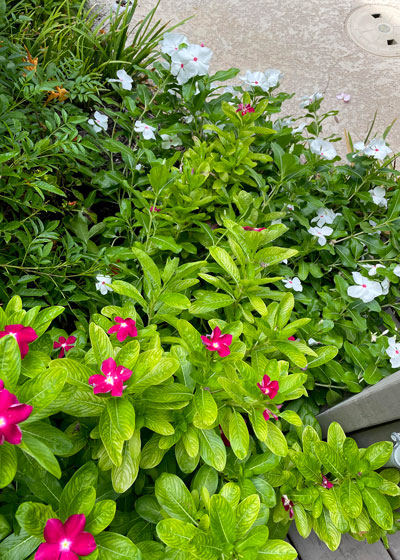
Answer: You do indeed have two separate vincas. The dark rose one looks like a Cora. I’m not sure about the white one. It could be just a chance seedling. As for the leaf discoloration on the rose-colored plants, it’s nutritional. Add a complete-and-balanced, water-soluble fertilizer with a trace elements package included. That will take care of nitrogen deficiency, the most common late-summer nutrient deficiency, but it will also correct anything else that might be missing. Repeat every 10-14 days.
QUESTION 12
WHAT IS HAPPENING TO LEAVES OF SAWTOOTH OAK?
Question: The leaves of my sawtooth oak are looking lacy, like the leaf is rotting. Some have dark spots. This is its first season. What is happening? Jerry G., Leander.
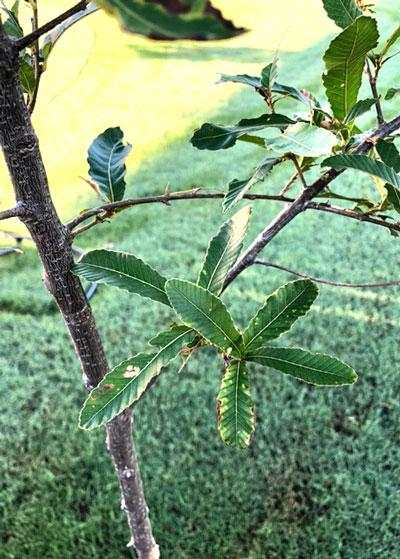
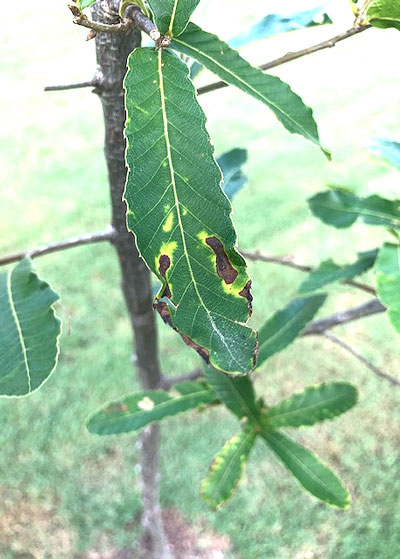
Answer: Sawtooth oaks are best suited to the acidic soils of the Southeast U.S. and East Texas https://plants.ces.ncsu.edu/plants/quercus-acutissima/. The farther west you go in our state the more they are challenged by the heat and drought, also definitely by the alkaline soils. They prefer soils with a pH of less than 6.0. You’re seeing a combination of those challenges on your young tree. I don’t know the soils of Leander, but much of the I-35 corridor has very alkaline black clay that is quite inhospitable to East Texas plants. I hope it does well for you, but I am concerned.
QUESTION 13
WHAT HAS CAUSED THE SPOTS ON THE LEAVES OF MY EAST PALATKA HOLLY?
Question: This East Palatka holly has been a real star in my landscape and I love it. However, I’m worried about the spots on its leaves. Any ideas? Jim B., Little Elm, Denton County.

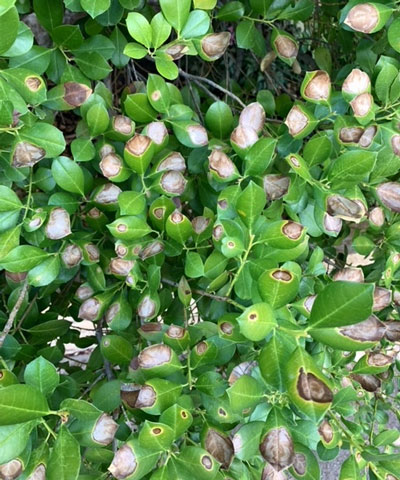
Answer: This plant has gotten too dry some weeks ago. If you’ll keep watering it properly from this point forward it should be fine. You’re lucky it didn’t get any drier.
QUESTION 14
CAN THESE CRAPE MYRTLES BE SAVED?
Question: This 30-year-old grove of crape myrtles at the entryway to our neighborhood has prompted HOA landscapers to suggest the removal of the trees and replanting of the median. Granted, the trees are crowded and tangled and the groundcover beneath them is sparse, but many of us in the neighborhood want to save them. There’s drip irrigation (efficient, we think), but the highly mounded roots may prevent rainfall from soaking in. We are also concerned about the soil depth and fertilization. All advice appreciated. Michael K., Richardson.
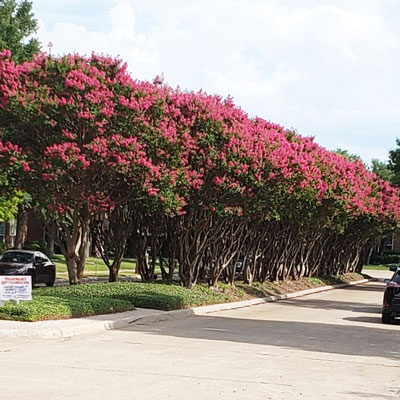

Answer: Oh, how I hope these don’t get removed. It’s a lovely planting that many other neighborhoods would love to have. The mounded berm was probably there as the crape myrtles were planted (bed prep plus the extra soil from when the holes were dug). The groundcover 30 years ago was probably Asian jasmine. I can’t zoom in on the photo to see it any better, but much of it was probably lost in last year’s cold. That’s what happened to Asian jasmine. New plants could easily enough be planted from 1-gallon pots set between the crape myrtles next spring. Drip irrigation down the middle of the bed – a couple of rows of drip lines – perfect solution, rain or no rain. Yes, the plants are too close together, but good gracious, look at how beautiful they are as a mass. How ‘bout we leave them until some real problem develops. This is beautiful. There’s nothing that needs to be fixed here now.
